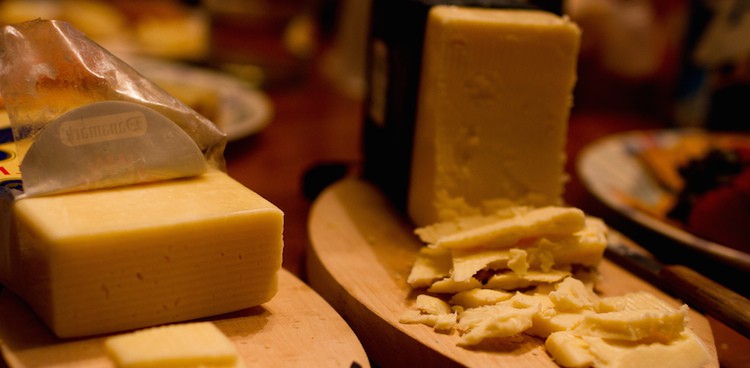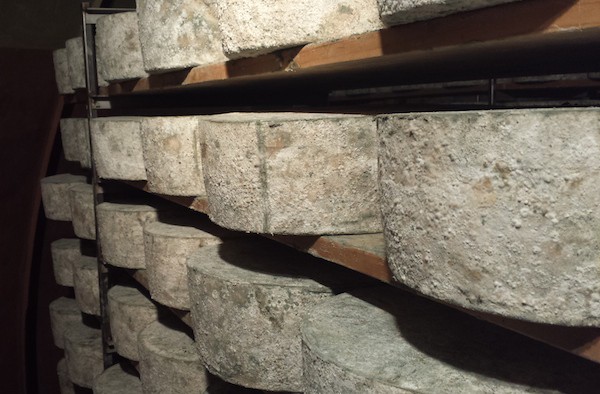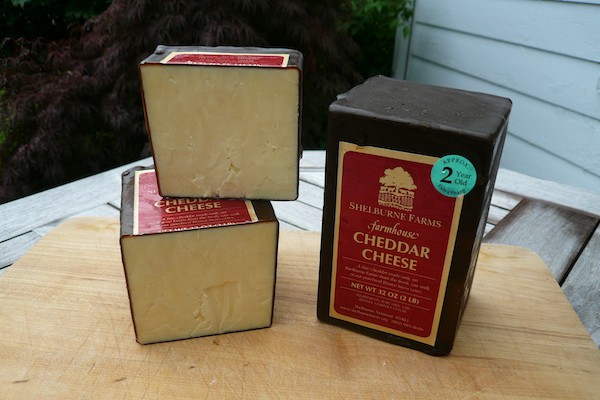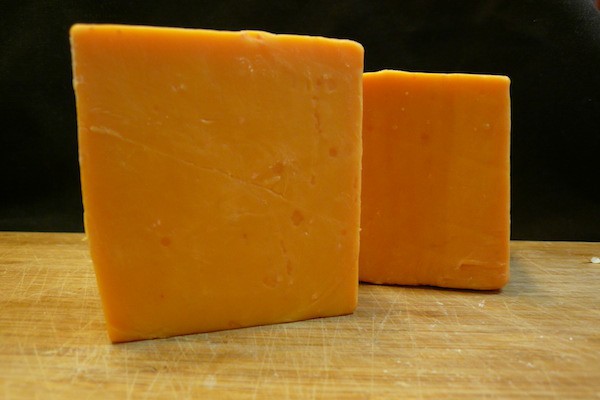
Cheddar is one of the most common cheeses here in the states. While artisan cheesemakers have gone wild with variations from goat to clothbound to blue, the cheddar most of us are familiar with is the plastic-wrapped block you can find at the grocery store. But how much do you really know about this popular cheese?
What’s in a Name?
Cheddar originated in the middle ages in the town of Cheddar in Somerset, England, which is where it gets its name. It was made using a unique process called “cheddaring,” in which the cheese curds are allowed to sit together (and are sometimes even stacked into towers) after they coagulate. While this story sounds very much like that of many protected by origin cheeses (think Roquefort or Camembert), because England experienced an early industrialization of its dairy industry, cheddar cheese never gained a protected status. Today any cheesemaker can call their cheese a cheddar if they feel like it… whether it was made by cheddaring or not.

Clothbound cheddars, like this one from Bleu Mont Dairy, are traditionally cave aged and develop more mild, earthy flavors as they lose moisture.
Aging Gracefully
One of the biggest differences between traditional English cheddar and the American variety is the way that the cheeses are aged. English cheddar is normally cylindrical in shape, bound in permeable cheesecloth (hence the term “clothbound”), and its flavors range from earthy to nutty to caramelized. The Puritans, who emigrated from England in the 1600s, originally aged their cheeses the same way their countrymen across the Atlantic did, wrapped in cotton. However, they soon discovered that cheddars aging through New England summers required more protection than a wrapper of cloth could provide.
Early Americans began searching for ways to further protect their cheeses. They began by smearing the surface of the cheese with butter. Over time this practice evolved through the use of lard and then paraffin. Finally, once the petroleum industry lead to plentiful and cheap wax, waxed cheddar cheeses were born.

American-style cheddars like this one from Shelburne Farms are often coated in wax for protection during aging.
Today, American-style cheddar is often known as “block cheddar” because it is formed into large blocks that can weigh 600 pounds apiece. These blocks are generally coated in wax or plastic to protect them while they age, leaving to flavors that can range from unassumingly mild to extremely sharp depending on the length of the aging process.
Sharp as a Tack
Cheddars that have been sealed in plastic are well protected from spoilage caused by outside influences, such as heat, moisture, or molds and yeasts carried to the surface of the cheese by the air. In addition, because the plastic is air-tight, these cheddars don’t lose moisture the way that a clothbound cheddar would. Because of this, block cheddar can age for an incredibly long time. Your typical grocery store cheddar might be as old as 3 years. Some cheesemakers push the extremes—Hook’s Cheese in Wisconsin sells a 15-year-old cheddar. The current record for cheddar aged in plastic stands at over 40 years.

Orange cheddar, like this one from Hook’s, is made by the same process as white, but uses annatto extract to color the curd. In the U.S., cheddars from the Midwest are more likely to be orange, while cheddars from the Northeast tend to be pale yellow.
The longer a cheddar is aged, the “sharper” it becomes. This happens because the bacteria that was added to the cheese when it was first made continues to break down the fats and proteins in the sealed cheese. This anaerobic process (basically meaning that it happens in the airless environment within the sealed plastic) forms compounds such as aldehydes, esters, and lactic acids. These compounds are expressed in the flavor we know as “sharpness”. Because sharpness is made up of so many compounds, it can range from a slight sour prickle on the tongue to much stronger flavors that are pungent or have a distinct bite. These flavors are in distinct contrast with the more mellow and earthy flavors associated with cheddar aged in cloth.
Pair it Up
Many would argue that aged, sharp cheddar is perfect on its own, but like most cheeses, plastic-aged cheddar pair well with a variety of drinks and foods.
- IPA. The floral, bitter hoppiness of these beers works well to balance the strong sharp flavors in these cheeses. The carbonation is also great for washing away the heavy mouthfeel of the moist cheese.
- Sweet flavors are a great way to add contrast to a cheeseboard that features sharp cheddar. Look for fruits that are more sweet than tangy, such as strawberries or grapes. Also, jam makes a great pairing partner for sharp cheddar.
- Try sharp cheddar in recipes that call for grated or melted cheese, such as this Cheddar Corn Soufflé or this Cheddar, Ham, and Jam Grilled Cheese.
Photo Credit: Featured image courtesy of waitscm via Compfight cc



